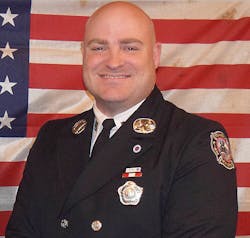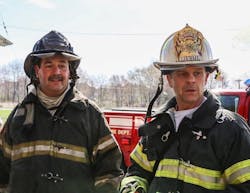Firehouse Expo: Where the Rubber Meets the Road
The 2022 edition of Firehouse Expo was the event of the year for training and education. For those who weren’t able to attend, the following takeaways of three educational sessions synopsize the kind of unique information that you can obtain at Firehouse.com and on social media using #FHExpo22.
Setting the Strategic Vision
By John Dixon
Developing and implementing a strategic vision are key to moving fire departments forward. The vision can be set for administrative, operational and training.
In his program, “Strategic Vision Planning: How to Seek Continuous Organizational Improvement,” Battalion Chief John Dixon shared how his fire department in Teaneck, NJ, utilized the National Fallen Firefighters Foundation (NFFF) document to map its strategic plan. The four-step process includes: initiating, creating, executing and monitoring the plan.
The process began when an anonymous survey collected data from all ranks within the organization. This included how the department utilized the NFFF’s 16 Life Safety Initiatives in its day-to-day operations. Once compiled, the group looked at its top-down and bottom-up operations and how the suggestions could be implemented to improve myriad processes.From the rookie to the fire chief, everyone had to be included, Dixon said.
“With the NFFF documents, we no longer had to reinvent the wheel, and that was what made the process efficient,” Dixon said. Without the document, Dixon said the process would have dragged on.
On the operations side, a dedicated officer position was added to the department’s only truck company for the first time in its existence, allowing the truck to operate as a dedicated team.
Also, to double its technical rescue capabilities, the department removed its front-line rescue and turned two engine companies into squad companies. They provided more specially trained personnel and equipment to be available in the community.
The department revamped all of its standard operating guidelines and improved leadership training based on feedback.
From the beginning to end of the process, there is “no secret in the sausage making process,” Dixon said.
Three takeaways:
1. Communication is key. Everything had to be communicated to ensure that each member operated on a level playing field.
2. Get buy-in from each rank of the organization. Without feedback and buy-in, the vision will be challenging to implement.
3. Give your honest feedback during the evaluation process. To move forward and to raise the bar, transparency is needed.
Emergency Incident Communications
By John J. Lewis and Robert Moran
After listening to radio traffic from incidents around the country, Passaic, NJ, Lt. (Ret.) John J. Lewis and Brewster, MA, Fire Chief Robert Moran set out to share best practices to ensure that attendees know how to use the radio, particularly when their life is on the line.
In “Emergency Radio Communications: What to Say When It Matters the Most,” Lewis and Moran pull apart the transmissions to separate them into three categories: emergency radio traffic, urgent traffic and mayday messages.“There’s a lot of good audio out there about bad radio traffic, and we want to help firefighters prepare for their emergency,” Lewis said. “If you pay attention to the mayday traffic, you notice quite often people don’t pick up the maydays or urgent messages, not the sense of urgency.”
The session dug into emergency radio traffic, such as “Ventilation is needed,” and urgent traffic, such as “Immediate need for water on a hoseline” and “Imminent collapse.” Maydays should be reserved for times when members are in danger.
Lewis and Moran suggested the continued use of LUNAR (Location, Unit, Name, Air level and Resources.)
“You need to say what matters the most, right then and there,” Lewis said. “We talk about RIT, RIT, RIT, but how often do we talk about what to do if you’re calling the mayday? Location is critical, because it sends the help where it’s needed.”
Three takeaways:
1. Train for your mayday calls. As an individual and as a crew, take the time to practice calling the mayday and the information within LUNAR. Do it on air and in realistic conditions. You don’t want to call a mayday without having prepared for it.
2. Study your department’s guidelines after a mayday is called. Do you change channels? Who monitors the mayday, and who monitors the incident? Changing channels might lead to key information, such as possible location, changing conditions or hearing the PASS alarm on a channel where the messages are missed.
3. Recognize the difference between the three situations and know when to use the appropriate messages.
The Leader’s Desk
By Brandon Fletcher
Fire Chief Brandon Fletcher believes in the idiom “he grass isn’t always greener.”
In his session, “Views from the Other Side of the Desk,” Fletcher pulled from the lessons from his leadership journey, including from his current role as fire chief of the Gilt Edge, TN, Fire Department, and that of others to help officers to navigate the expected—and, often, unexpected-challenges of being and officer and a chief. The lessons start from the informal leadership role at the rank of firefighter and continue through becoming a company officer, deputy chief and fire chief in his current department, plus his previous fire service roles.“How you view things, particularly policies, procedures and personal actions, changes as you climb the ladder,” Fletcher said. Some of the challenges can be easy to navigate, and others can leave you seeking advice from others.
Plus, Fletcher stressed, you aren’t only accountable for your actions but for those of the others who are in your department. You must be prepared to answer for them and work through myriad scenarios.
Always learn from the good and bad experiences, Fletcher stressed, whether they happened to you or to others. Ask questions to better understand how people got into those situations and what they did to resolve them.
Fletcher said he has gleaned a pointed leadership from his colleagues who he met through networking, too. Whether meeting people at conferences, such as Firehouse Expo, or reaching out to others in similar roles, expanding your network provides access to new management ideas, skillsets, perspectives and understandings. As a leader, the more well-rounded you are, the better prepared you are.
Three takeaways:
1. The view always is different as you promote. No matter what you think, your decisions will change as you become more accountable.
2. Remember where you came from. As you climb the ladder, never forget the ranks that you held and the positions that you have been in. Along the way, embrace change and don’t become disconnected.
3. Reach out in your network for help and advice. Peers who are at the same level or higher might have had similar experiences or can connect you with someone when you need direction. Also, always expand your network.
About the Author
Firehouse Staff
Content written and created by Firehouse Magazine editors.



